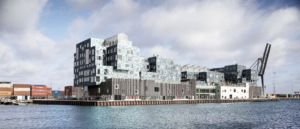Opinion
Masterclass in sustainability: my alma mater is the school of the future
This article is more than 5 years old.
Three years after its move to Nordhavn, Copenhagen International School continues to set the standards for the rest to follow

A waterfront gem of learning (photo: C F Møller Architects)
Long before anyone finds out about the Copenhagen jazz festival, business school, fashion week, zoo, or even contemporary, celtic and post, they learn about Copenhagen International School. Type the name of the Danish capital into Google and see what comes up first!
Copenhagen International School is pre-eminent in every way: its educational excellence, its close-knit and welcoming community, the way its student body takes responsibility locally and globally and – last, but not least – sustainability.
Some 25,000 sqm in size, its new premises is truly a building of the future. A blossoming ground for innovation and creativity, it’s no wonder so many of its students shine so bright when they complete their education.
Worthy of ocean views
The building, which officially opened in January of 2017, is nearly entirely covered by a solar panel facade that has the ability to produce about 50 percent of the school’s energy consumption.
The 12,000 solar panels were specifically designed for the building to produce power to service CIS’s bid to be energy-sufficient.
However, a lot of thought also went into them looking visually appealing. Due to the lack of variation in the solar panels that existed at the time, they were given a green/blue tint similar to the ocean that surrounds the building, along with a slant to give the outside of the building a more interesting look.
Lit, fed, cooled
The solar facade is perhaps the most conspicuous environmentally-conscious element, but certainly not the only one.
The school’s cafeteria is also very environmentally aware, as none of the leftover food is thrown away. When the children are done eating, their leftovers end up being used for biogas and/or fed to animals. The biogas might be used to, for example, fuel the blue buses in Copenhagen.
The building is entirely illuminated by LED lights, which are far more energy-efficient than regular light bulbs, making them much better for the environment.
The school is also so well insulated it requires a cooling system. The cooling system pulls in fresh air from the roof, where it’s always cooler, in order to ventilate without actively cooling (which would use a lot more energy). In addition, a 3x air exchange ensures the indoor environment is conducive to learning.
The next generation
So what kind of impact does this have? Aside from the obvious positive impact of composting and solar energy, putting children in an environmentally-aware and responsible atmosphere is also crucial.
In a world where global warming is progressing at a rapid rate, action needs to be taken immediately, and that must start at a young age. When children are raised in environments in which sustainability is prioritised, it is natural to assume that they will learn the value and significance of it.
And what we need now is more people growing up with the understanding that we must take action to save the planet.
Healthy children
And it doesn’t stop there, as the health of the children is paramount. Not only is the food they eat both fresh and healthy, but their classrooms are lit in such a way to optimise their working levels.
Almost all of the classrooms are placed in corners of the building in order to maximise the amount of natural light they receive. When children are exposed to lots of bright light it makes them happier, more energised, and more inclined to focus.
Furthermore the classes are mostly furnished (the floors, lockers, cupboards etc) using sustainable materials such as wood, which is both better for the students’ well-being and for the environment.
Location, location …
The school is significantly located in Nordhavn, a rapidly emerging area in Copenhagen with a focus on sustainability, where the blue undertones of the solar paneled facade has become something of a poster-girl for the district.
Nordhavn is intent on becoming completely carbon-neutral. It has become much easier to cycle and use public transport than drive, thus promoting emission-free modes of transportation.
A new Metro station, which has opened just a few minutes away from CIS, makes it easy for students to use public transport instead of being driven to school.
It has further solidified the school’s status as a trailblazer for sustainable architecture and education, and the benefits of this are already starting to manifest. As the century unfolds, expect to see more institutions follow suit in pursuit of their own sustainable and green futures.
Anna Maryam Smith, a graduate of Copenhagen International School in 2019, has just started her second year at Wellesley College in Boston, where she is studying liberal arts.
About










































